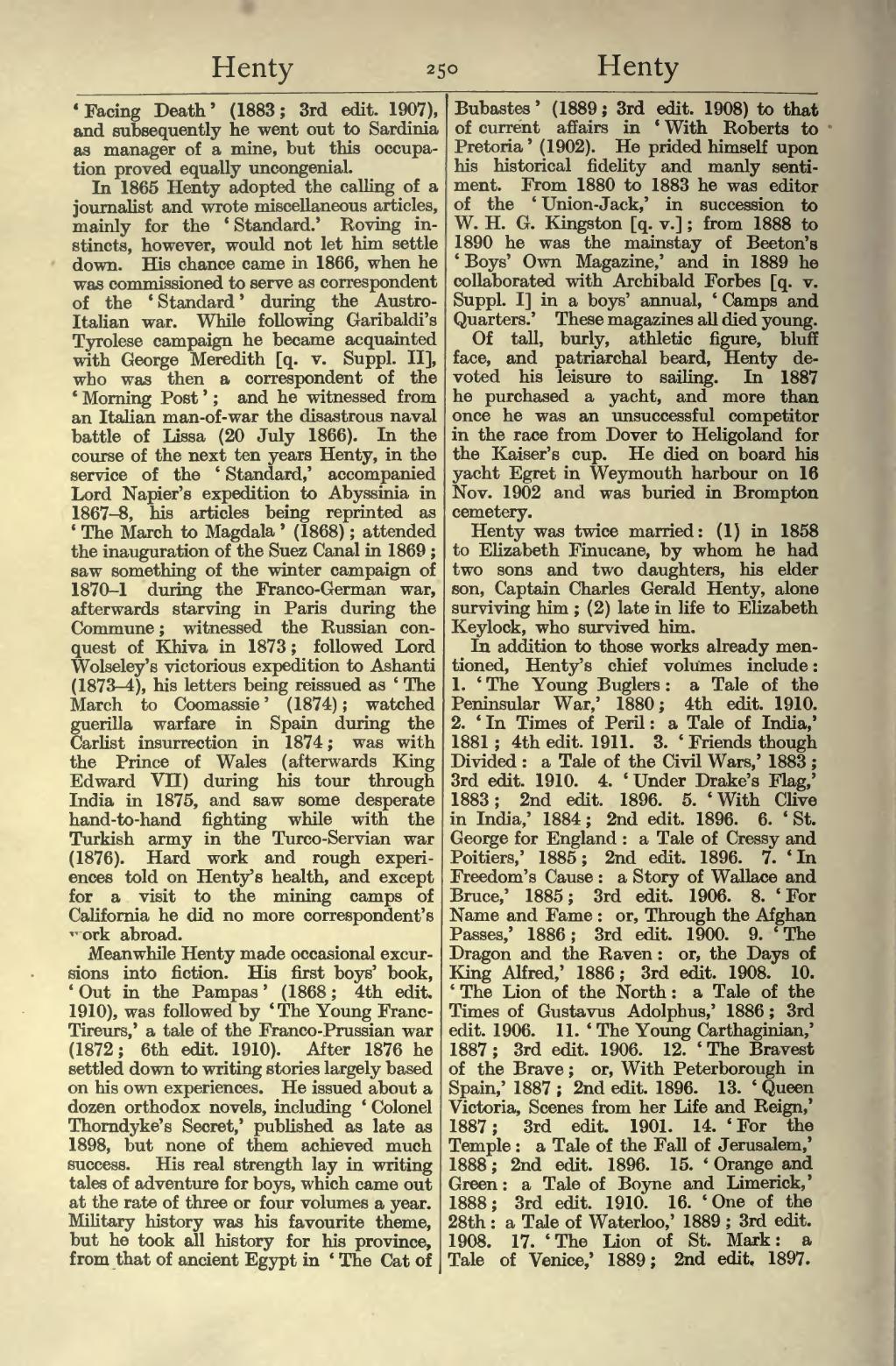‘Facing Death’ (1883; 3rd edit. 1907), and subsequently he went out to Sardinia as manager of a mine, but this occupation proved equally uncongenial.
In 1865 Henty adopted the calling of a journalist and wrote miscellaneous articles, mainly for the ‘Standard.’ Roving instincts, however, would not let him settle down. His chance came in 1866, when he was commissioned to serve as correspondent of the ‘Standard’ during the Austro-Italian war. While following Garibaldi's Tyrolese campaign he became acquainted with George Meredith [q. v. Suppl. II], who was then a correspondent of the ‘Morning Post’; and he witnessed from an Italian man-of-war the disastrous naval battle of Lissa (20 July 1866). In the course of the next ten years Henty, in the service of the ‘Standard,’ accompanied Lord Napier's expedition to Abyssinia in 1867–8, his articles being reprinted as ‘The March to Magdala’ (1868); attended the inauguration of the Suez Canal in 1869; saw something of the winter campaign of 1870–1 during the Franco-German war, afterwards starving in Paris during the Commune; witnessed the Russian conquest of Khiva in 1873; followed Lord Wolseley's victorious expedition to Ashanti (1873–4), his letters being reissued as ‘The March to Coomassie’ (1874); watched guerilla warfare in Spain during the Carlist insurrection in 1874; was with the Prince of Wales (afterwards King Edward VII) during his tour through India in 1875, and saw some desperate hand-to-hand fighting while with the Turkish army in the Turco-Servian war (1876). Hard work and rough experiences told on Henty's health, and except for a visit to the mining camps of California he did no more correspondent's work abroad.
Meanwhile Henty made occasional excursions into fiction. His first boys' book, ‘Out in the Pampas’ (1868; 4th edit. 1910), was followed by ‘The Young Franc-Tireurs,’ a tale of the Franco-Prussian war (1872; 6th edit. 1910). After 1876 he settled down to writing stories largely based on his own experiences. He issued about a dozen orthodox novels, including ‘Colonel Thorndyke's Secret,’ published as late as 1898, but none of them achieved much success. His real strength lay in writing tales of adventure for boys, which came out at the rate of three or four volumes a year. Military history was his favourite theme, but he took all history for his province, from that of ancient Egypt in ‘The Cat of Bubastes’ (1889; 3rd edit. 1908) to that of current affairs in ‘With Roberts to Pretoria’ (1902). He prided himself upon his historical fidelity and manly sentiment. From 1880 to 1883 he was editor of the ‘Union-Jack,’ in succession to W. H. G. Kingston [q. v.]; from 1888 to 1890 he was the mainstay of Beeton's ‘Boys' Own Magazine,’ and in 1889 he collaborated with Archibald Forbes [q. v. Suppl. I] in a boys' annual, ‘Camps and Quarters.’ These magazines all died young.
Of tall, burly, athletic figure, bluff face, and patriarchal beard, Henty devoted his leisure to sailing. In 1887 he purchased a yacht, and more than once he was an unsuccessful competitor in the race from Dover to Heligoland for the Kaiser's cup. He died on board his yacht Egret in Weymouth harbour on 16 Nov. 1902 and was buried in Brompton cemetery.
Henty was twice married: (1) in 1858 to Elizabeth Finucane, by whom he had two sons and two daughters, his elder son, Captain Charles Gerald Henty, alone surviving him; (2) late in life to Elizabeth Keylock, who survived him.
In addition to those works already mentioned, Henty's chief volumes include: 1. ‘The Young Buglers: a Tale of the Peninsular War,’ 1880; 4th edit. 1910. 2. ‘In Times of Peril: a Tale of India,’ 1881; 4th edit. 1911. 3. ‘Friends though Divided: a Tale of the Civil Wars,’ 1883; 3rd edit. 1910. 4. ‘Under Drake's Flag,’ 1883; 2nd edit. 1896. 5. ‘With Clive in India,’ 1884; 2nd edit. 1896. 6. ‘St. George for England: a Tale of Cressy and Poitiers,’ 1885; 2nd edit. 1896. 7. ‘In Freedom's Cause: a Story of Wallace and Bruce,’ 1885; 3rd edit. 1906. 8. ‘For Name and Fame: or, Through the Afghan Passes,’ 1886; 3rd edit. 1900. 9. ‘The Dragon and the Raven: or, the Days of King Alfred,’ 1886; 3rd edit. 1908. 10. ‘The Lion of the North: a Tale of the Times of Gustavus Adolphus,’ 1886; 3rd edit. 1906. 11. ‘The Young Carthaginian,’ 1887; 3rd edit. 1906. 12. ‘The Bravest of the Brave; or, With Peterborough in Spain,’ 1887; 2nd edit. 1896. 13. ‘Queen Victoria, Scenes from her Life and Reign,’ 1887; 3rd edit. 1901. 14. ‘For the Temple: a Tale of the Fall of Jerusalem,’ 1888; 2nd edit. 1896. 15. ‘Orange and Green: a Tale of Boyne and Limerick,’ 1888; 3rd edit. 1910. 16. ‘One of the 28th: a Tale of Waterloo,’ 1889; 3rd edit. 1908. 17. ‘The Lion of St. Mark: a Tale of Venice,’ 1889; 2nd edit. 1897.
